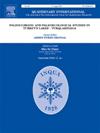Small-mammalian fossils from the Paleolithic Dayin Cave site in Yunnan, Southwest China
IF 1.8
3区 地球科学
Q3 GEOGRAPHY, PHYSICAL
引用次数: 0
Abstract
Small mammals have short life spans, rapid reproductive cycles, wide distributions, and are sensitive to climate change. Composition of small mammal faunas is useful for reconstructing the paleoenvironment. Here we report the small mammals unearthed from the Dayin Cave, an archaeological site in Yunnan Province, Southwest China. Screen washing yielded two small mammal faunas. One has a radiocarbon date of approximately 32 ka BP. The other has a radiocarbon date around 18 ka BP, equivalent to the period of the Last Glacial Maximum (LGM). We performed taxonomic analyses, faunal comparisons, principal component analysis and cluster analyses on the small mammal fossils from the Dayin Cave. Our results show most of the species from the older fauna (∼32 ka) are forest-dwelling species, indicating the flourishing of forests and a relatively warm and humid climate. The younger fauna is dominated by Eothenomys, today an alpine-subalpine shrubland dweller, suggesting the flourishing of shrublands and perhaps a decrease in temperature. The stone tools discovered from the fossiliferous Layers 1 and 2 in. the Dayin Cave belong to the same type, suggesting that they were probably used by one hunter-gatherer group that lived in the Dayin Cave, and the populations were not affected by the cooling of the climate.
中国西南云南旧石器时代大荫洞遗址的小型哺乳动物化石
小型哺乳动物寿命短,繁殖周期快,分布广,对气候变化敏感。小型哺乳动物区系的组成对古环境的重建具有重要意义。在这里,我们报道了在中国西南部云南省考古遗址大荫洞出土的小型哺乳动物。洗网发现了两种小型哺乳动物。其中一个的放射性碳年代约为32ka BP。另一个的放射性碳测年约为18 ka BP,相当于末次盛冰期(LGM)。对大荫洞小型哺乳动物化石进行了分类分析、区系比较、主成分分析和聚类分析。我们的研究结果表明,来自更古老的动物群(~ 32 ka)的大多数物种都是森林栖息物种,这表明森林繁荣,气候相对温暖潮湿。较年轻的动物群主要是Eothenomys,今天是高山-亚高山灌木丛的居民,这表明灌木丛的繁荣可能是温度下降的结果。从1层和2层化石中发现的石器。大隐洞属于同一类型,这表明它们可能是生活在大隐洞的一个狩猎采集者群体使用的,而且人口没有受到气候变冷的影响。
本文章由计算机程序翻译,如有差异,请以英文原文为准。
求助全文
约1分钟内获得全文
求助全文
来源期刊

Quaternary International
地学-地球科学综合
CiteScore
5.60
自引率
4.50%
发文量
336
审稿时长
3 months
期刊介绍:
Quaternary International is the official journal of the International Union for Quaternary Research. The objectives are to publish a high quality scientific journal under the auspices of the premier Quaternary association that reflects the interdisciplinary nature of INQUA and records recent advances in Quaternary science that appeal to a wide audience.
This series will encompass all the full spectrum of the physical and natural sciences that are commonly employed in solving Quaternary problems. The policy is to publish peer refereed collected research papers from symposia, workshops and meetings sponsored by INQUA. In addition, other organizations may request publication of their collected works pertaining to the Quaternary.
 求助内容:
求助内容: 应助结果提醒方式:
应助结果提醒方式:


